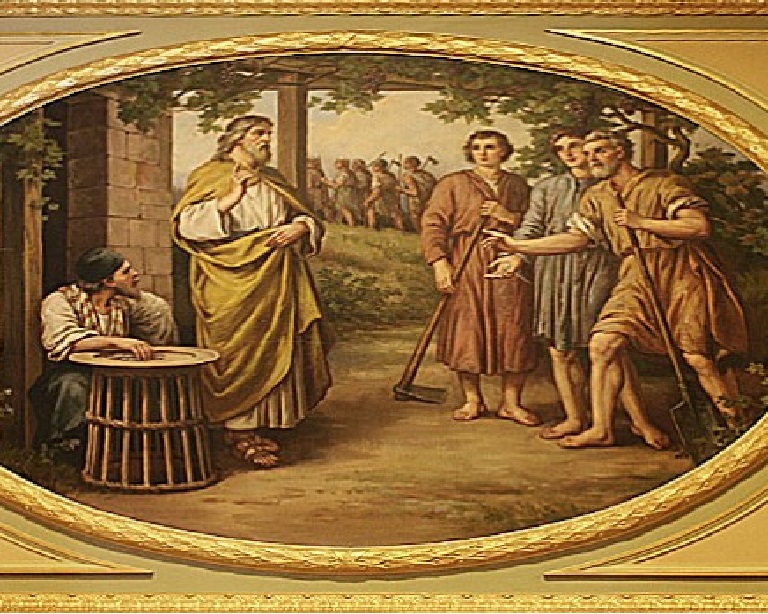Proverbs 8:22-31
Ps 8:4-5, 6-7, 8-9
Rom 5:1-5
Jn 16:12-15
The Solemnity of the Most Holy Trinity should be the great crescendo of the Easter Season, the culmination of the revelation of God to His people. In reality, it always falls a little flat. What can we say about the Trinity without lapsing into heresy? The reality of the Trinity is a reality that almost demands silence. But that would make for a very short blog post so let me at least attempt to say something!
It is interesting and significant that Trinity Sunday follows immediately after Pentecost, the birthday of the Church. We only come to know God as Trinity in and through the Church. The Bible never states explicitly that God is Trinity, and yet, the Trinity is the center of the Christian faith as the Catechism makes clear:
The mystery of the Most Holy Trinity is the central mystery of Christian faith and life. It is the mystery of God in himself. It is therefore the source of all the other mysteries of faith, the light that enlightens them. It is the most fundamental and essential teaching in the “hierarchy of the truths of faith” (234)
In fact, our first reading from Proverbs is a reminder of the challenges of coming to the conclusion of the Trinity through Scripture alone. This particular passage was used by the Arians (followers of a heretical view that denied the full divinity of Christ) to argue that Jesus was created, and as such, something less than God the Father who had no beginning. The Council of Nicea concluded that the views of Arius were wrong, declaring instead that Jesus was homoousious (of the same substance) with God the Father. It is from this first ecumenical council that we get the backbone of the creed we say every Sunday, the creed which expresses our faith in one God who is Father, Son, and Spirit.
Our Gospel reading shows us that the revelation of God, though complete in Jesus, is not completely explicit in Jesus, but must progressively be made more explicit over time. Jesus says to his disciples,
“I have much more to tell you, but you cannot bear it now.
But when he comes, the Spirit of truth,
he will guide you to all truth.
He will not speak on his own,
but he will speak what he hears . . .
For Catholics, this Spirit of truth is the Holy Spirit which guides the Church as she continues to teach and make explicit the faith. The Trinity is at the center of this living faith. As the Catechism states, the mystery of the Trinity “finds its expression in the rule of baptismal faith, formulated in the preaching, catechesis and prayer of the Church” (249). Paul’s allusion to baptism in our reading from Romans is not at all insignificant. He writes that the “love of God has been poured out into our hearts through the Holy Spirit that has been give to us.” In other words, we come to know the faith, we come to know the teaching of the Trinity, by being incorporated into the faith of the Church through baptism and the corresponding reception of the Holy Spirit.
What does this have to do with moral theology? Through baptism and the Holy Spirit, the believer is incorporated into the Church and into the body of Christ. As such, she assumes a new existence with new standards of excellence that are none other than the standards of Christ himself. Moral theologian Livio Melina writes in Sharing Christ’s Virtues that “belonging to Christ as members of one body bestows, at the level of the Church, the gift of the ‘we’ consciousness, without diminishing the personal responsibility of each, according to the model of the Most Holy Trinity.”
The life the Christian lives is necessarily a communal life, a corporate life that bears the image of the communal Trinitarian God that is its source. The community we are incorporated into provides a moral consciousness, a goal, and a set of standards that forms the life of the individual believer, not as an individual alone but as a part of the body.
Additionally, this ecclesial dimension of moral theology also reveals the integral connection between faith and the moral life. There is no separating the faith of the believer from the life she lives, as is made clear in our reading from Romans. Having gained access to grace by faith we
even boast of our afflictions,
knowing that affliction produces endurance,
and endurance, proven character,
and proven character, hope . . .
The moral life is, as such, not only about being good, but about being holy. The holiness of God is communicated to the believers through the sacraments, and the believer grows in holiness through actions marked by charity. The fertile ground for this dynamic life is the Church.
On this feast of the Holy Trinity we celebrate a God who is inherently relationship and who reveals himself through the relational body of the Church. And as we worship, we become incorporated into that Trinitarian life that communicates its own holiness to us so that we may bear the mark of the Trinitarian God on our own lives.



